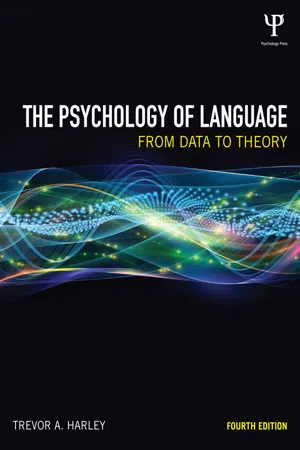![]()
Adams, M. J. (1990). Beginning to read: Thinking and learning about print. Cambridge, MA: MIT Press.
Ainsworth-Darnell, K., Shulman, H. G., & Boland, J. E. (1998). Dissociating brain responses to syntactic and semantic anomalies: Evidence from event-related potentials. Journal of Memory and Language, 38, 112–130.
Aitchison, J. (1994). Words in the mind: An introduction to the mental lexicon (2nd ed.). Oxford: Blackwell.
Aitchison, J. (1996). The seeds of speech: Language origin and evolution. Cambridge: Cambridge University Press.
Aitchison, J. (1998). The articulate mammal (4th ed.). London: Routledge.
Akhtar, N. (1999). Acquiring basic word order: Evidence for data-driven learning of syntactic structure. Journal of Child Language, 26, 339–356.
Akhtar, N., & Tomasello, M. (1997). Young children’s productivity with word order and verb morphology. Developmental Psychology, 33, 952–965.
Alario, F.-X., & Caramazza, A. (2002). The production of determiners: Evidence from French. Cognition, 82, 179–223.
Alario, F.-X., Costa, A., & Caramazza, A. (2002a). Frequency effects in noun phrase production: Implications for models of lexical access. Language and Cognitive Processes, 17, 299–319.
Alario, F.-X., Costa, A., & Caramazza, A. (2002b). Hedging one’s bets too much? A reply to Levelt (2002). Language and Cognitive Processes, 17, 673–682.
Alario, F.-X., Costa, A., Pickering, M., & Ferreira, V. (2006). Language production. Hove, UK: Psychology Press.
Albert, M. L., & Obler, L. K. (1978). The bilingual brain: Neuropsychological and neurolinguistic aspects of bilingualism. New York: Academic Press.
Alishahi, A., & Stevenson, S. (2005). A probabilistic model of early argument structure acquisition. Proceedings of the 27th Annual Conference of the Cognitive Science Society, Stresa, Italy.
Allopenna, P. D., Magnuson, J. S., & Tanenhaus, M. K. (1998). Tracking the time course of spoken word recognition: Evidence for continuous mapping models. Journal of Memory and Language, 38, 419–439.
Allport, D. A. (1977). On knowing the meaning of words we are unable to report: The effects of visual masking. In S. Dornic (Ed.), Attention and performance VI (pp. 505–534). Hillsdale, NJ: Lawrence Erlbaum Associates, Inc.
Allport, D. A. (1984). Auditory short-term memory and conduction aphasia. In H. Bouma & D. Bouwhis (Eds.), Attention and performance X (pp. 313–326). Hillsdale, NJ: Lawrence Erlbaum Associates, Inc.
Allport, D. A., & Funnell, E. (1981). Components of the mental lexicon. Philosophical Transactions of the Royal Society of London, Series B, 295, 397–410.
Almor, A. (1999). Noun-phrase anaphora and focus: The informational load hypothesis. Psychological Review, 106, 748–765.
Almor, A., Kempler, D., MacDonald, M. C., Andersen, E. S., & Tyler, L. K. (1999). Why do Alzheimer patients have difficulty with pronouns? Working memory, semantics, and reference in comprehension and production in Alzheimer’s disease. Brain and Language, 67, 202–227.
Altarriba, J. (1992). The representation of translation equivalents in bilingual memory. In R. J. Harris (Ed.), Cognitive processing in bilinguals (pp. 157–174). Amsterdam: North-Holland.
Altarriba, J. (Ed.). (1993). Cognition and culture: A cross-cultural approach to psychology. Amsterdam: North-Holland.
Altarriba, J., & Forsythe, W. J. (1993). The role of cultural schemata in reading comprehension. In J. Altarriba (Ed.), Cognition and culture: A cross-cultural approach to psychology (pp. 145–155). Amsterdam: North-Holland.
Altarriba, J., Kroll, J. F., Sholl, A., & Rayner, K. (1996). The influence of lexical and conceptual constraints on reading mixed-language sentences: Evidence from eye fixations and naming times. Memory and Cognition, 24, 477–492.
Altarriba, J., & Mathis, K. E. (1997). Conceptual and lexical development in second language acquisition. Journal of Memory and Language, 36, 550–568.
Altarriba, J., & Soltano, E. G. (1996). Repetition blindness and bilingual memory: Token individuation for translation equivalents. Memory and Cognition, 24, 700–711.
Altmann, G. T. M. (Ed.). (1990). Cognitive models of speech processing. Cambridge, MA: MIT Press.
Altmann, G. T. M. (1997). The ascent of Babel: An exploration of language, mind, and understanding. Oxford: Oxford University Press.
Altmann, G. T. M. (1999). Thematic role assignment in context. Journal of Memory and Language, 41, 124–145.
Altmann, G. T. M., Garnham, A., & Dennis, Y. (1992). Avoiding the garden path: Eye movements in context. Journal of Memory and Language, 31, 685–712.
Altmann, G. T. M., & Kamide, Y. (1999). Incremental interpretation at verbs: Restricting the domain of subsequent reference. Cognition, 73, 247–264.
Altmann, G. T. M., & Kamide, Y. (2009). Discourse-mediation of the mapping between language and the visual world: Eye movements and mental representation. Cognition, 111, 55–71.
Altmann, G. T. M., & Shillcock, R. C. (Eds.). (1993). Cognitive models of speech processing. Hove, UK: Lawrence Erlbaum Associates.
Altmann, G. T. M., & Steedman, M. J. (1988). Interaction with context during human sentence processing. Cognition, 30, 191–238.
Anderson, J. R. (1974). Retrieval of propositional information from long-term memory. Cognitive Psychology, 6, 451–474.
Anderson, J. R. (1976). Language, memory, and thought. Hillsdale, NJ: Lawrence Erlbaum Associates, Inc.
Anderson, J. R. (1983). The architecture of cognition. Cambridge, MA: Harvard University Press.
Anderson, J. R. (2010). Cognitive psychology and its implications (7th ed.). New York: Worth.
Anderson, J. R., & Bower, G. H. (1973). Human associative memory. Washington, DC: Winston & Sons.
Anderson, K. J., & Leaper, C. (1998). Meta-analyses of gender effects on conversational interruption: Who, what, when, where, and how. Sex Roles, 39, 225–252.
Anderson, R. C., & Pichert, J. W. (1978). Recall of previously unrecallable information following a shift in perspective. Journal of Verbal Learning and Verbal Behavior, 12, 1–12.
Andrewes, D. (2001). Neuropsychology: From theory to practice. Hove, UK: Psychology Press.
Andrews, S. (1982). Phonological recoding: Is the regularity effect consistent? Memory and Cognition, 10, 565–575.
Andrews, S. (1989). Frequency and neighborhood effects on lexical access: Activation or search? Journal of Experimental Psychology: Learning, Memory, and Cognition, 15, 802–814.
Andrews, S. (1997). The effect of orthographic similarity on lexical retrieval: Resolving neighborhood conflicts. Psychonomic Bulletin and Review, 4, 439–461.
Andrews, S. (2006). From inkmarks to ideas. Hove, UK: Psychology Press.
Ans, B., Carbonnel, S., & Valdois, S. (1998). A connectionist multiple-trace memory model for polysyllabic word reading. Psychological Review, 105, 678–723.
Antos, S. J. (1979). Processing facilitation in a lexical decision task. Journal of Experimental Psychology: Human Perception and Performance, 5, ...
